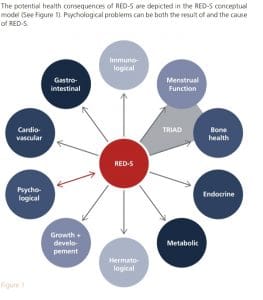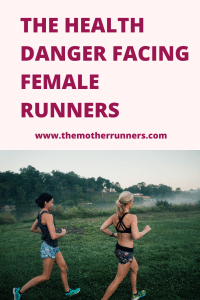Jen T. Scott, registered dietitian nutritionist in Beaverton, Oregon, shares an extremely important article below on RED-S Syndrome: a condition that affects many female athletes and can cause chronic and life-altering conditions. Sadly, up until now, this condition has been widely accepted as “normal” with little done to make societal changes to stop it.
I, myself, suffered from Relative Energy Deficiency Syndrome or RED-S. For three years, I did not get my period. I had heard this was normal as a female runner and didn’t think much about it. That changed when my husband I

wanted to start a family. I went to several specialists trying to get my menstrual cycle back on track. Their answers were always the same: take hormones and stop running. It didn’t work. It was frustrating and exhausting. I was lucky enough to find a doctor, pinpointing my condition as the Female Athlete Triad, which is caused by RED-S. He looked to the cause, improper nutrition, and helped me overhaul my diet so that my body felt like it had the resources it needed to support another life.
Now that ex-Nike runner Mary Cain has revealed the abuse she suffered at Nike which led to RED-S (such as her coaches pushing her to be thinner), we’re at a precipice of turning a tide. Read below to learn about RED-S and how we can stop it.
The Health Danger Facing Many Female Athletes
When Mary Cain shared her story several weeks ago, many of us in the running community were shocked. We also found that we had something in common with her: we have at one time in our lives found ourselves pursuing thinness (due to the pressure of coaches and/or society) and/or have lost our periods.
Unfortunately, the loss of a period has been talked about as a “normal” part of training, exercising more, running more, and/or losing weight. Sometimes it is even celebrated as a badge of honor. However, this is NOT normal. It is a major RED FLAG, and we need to start addressing it as such.
Related: What to eat after a long run

What is RED-S Syndrome?
Relative Energy Deficiency Syndrome (RED-S) is ‘’low energy availability’, where an individual’s dietary energy intake is insufficient to support the energy expenditure required for health, function, and daily living, once the cost of exercise and sporting activities is taken into account.” Simply put, it is when we are not eating enough to support all our body’s health functions in addition to the stress of exercise.
What causes RED-S?
RED-S can happen as a result of intentional diet restriction (trying to eat a lower amount of calories, restricting specific food groups, disordered eating, or an eating disorder) and unintentional (the athlete is just not eating enough due to simply not realizing it, lack of knowledge, limited resources, time constraints, traveling, etc.). It can happen to females and males, and it can happen at any size.
Your specific body has its own threshold. It may only tolerate a deficit of a few hundred calories a day, while another woman’s body can withstand a much larger deficit. It may also only be able to see a few drops in body fat percentage, while another woman’s can be healthy at a much lower. Your unique body has its own needs.
So how do you know if you are at risk for, or suffering from RED-S?
Related: What to eat during your period
Signs of RED-S:
- A loss or absence of your period, or lengthening of your cycle
- Low body fat percentage
- Prolonged low calorie intake
- A loss of 5 to 10% of your body mass (weight)
- Reduced bone mineral density
- 1 or more stress fractures during altered menstruation
- Disordered eating/eating disorder behaviors
Potential health risks of RED-S:
- Impaired immune function
- GI distress and dysfunction
- Decreased bone health and osteoporosis
- Less frequent periods; Oligomenorrhea (> 35 days between cycles); Amenorrhea (>90 days between cycles); and impaired fertility
- Endocrine dysfunction
- Metabolic impairment
- Impaired growth and development
- Psychological distress (depression, anxiety, irregular mood)
- Increased cardiovascular risk
Potential effects on performance of RED-S:
- Decreased endurance
- Increased injury
- Decreased training response
- Impaired judgment
- Decreased coordination
- Decreased concentration
- Increased irritability
- Depression
- Decreased glycogen stores
- Decreased muscle strength
If you are experiencing any of the above signs or are concerned about your intake, please know you are not alone! So many of us have been here and gone through this. And, many of us are dealing with it right now. The first step in getting help is to reach out to your coach (if you have one), your doctor, and find a sport certified registered dietitian. Seeking out therapy can help too if you find yourself dealing with a lot of mental distress. Treatment and recovery for RED-S looks different for everyone, but you are going to have to decrease (or even completely stop) intense activity and increase your energy intake (move less, eat more).
How do you treat RED-S?
The next step is a much bigger one and requires all of us. We need to fight back against the praise and worship of thinness and restriction: Coaches should encourage their athletes to be properly fueled and to weigh their words instead of their athletes. Society should stop giving people who are promoting detoxes, cleanses, juice fasts, restrictive dieting, and disordered eating practices platforms. Instead of, “Have you lost weight? Tell me all your secrets!” ask, “Are you feeling okay?”.
We need to turn this ship and change direction, and we can only do it when we stop giving the $20 billion dollar weight loss industry and the ideal that “thinner is better” so much of our power. Let’s instead make sure we are eating to fuel our bodies so they cannot only perform all their basic health functions, but so they can power through workouts and runs.
Let’s make sure we are eating in a way that allows us to have lots of energy, have strong bones and muscles, regular periods, and a vibrant social life. Let’s make sure we are helping each other to embrace our bodies no matter their size, no matter what the number on the scale is, and no matter what it looks like.
